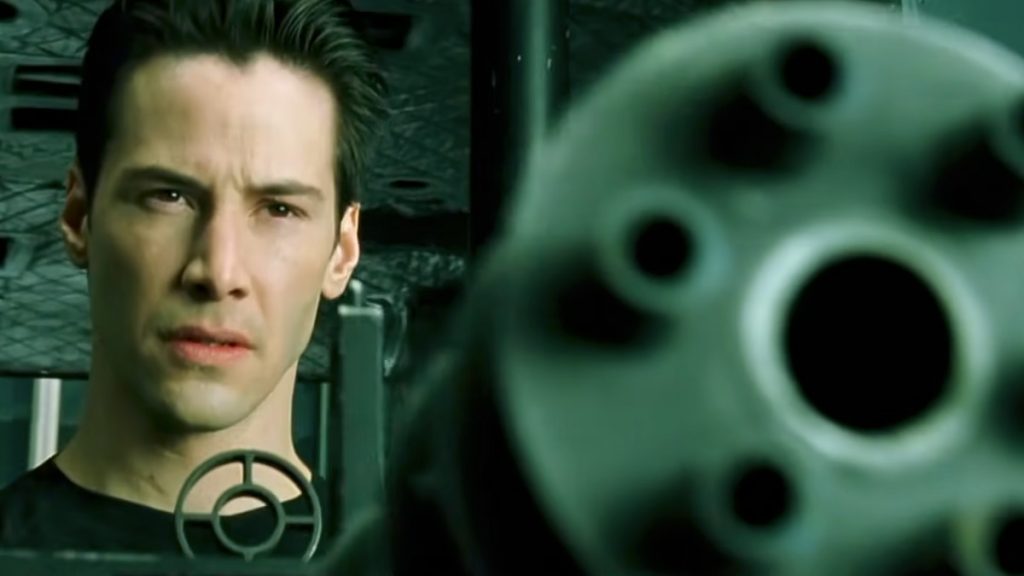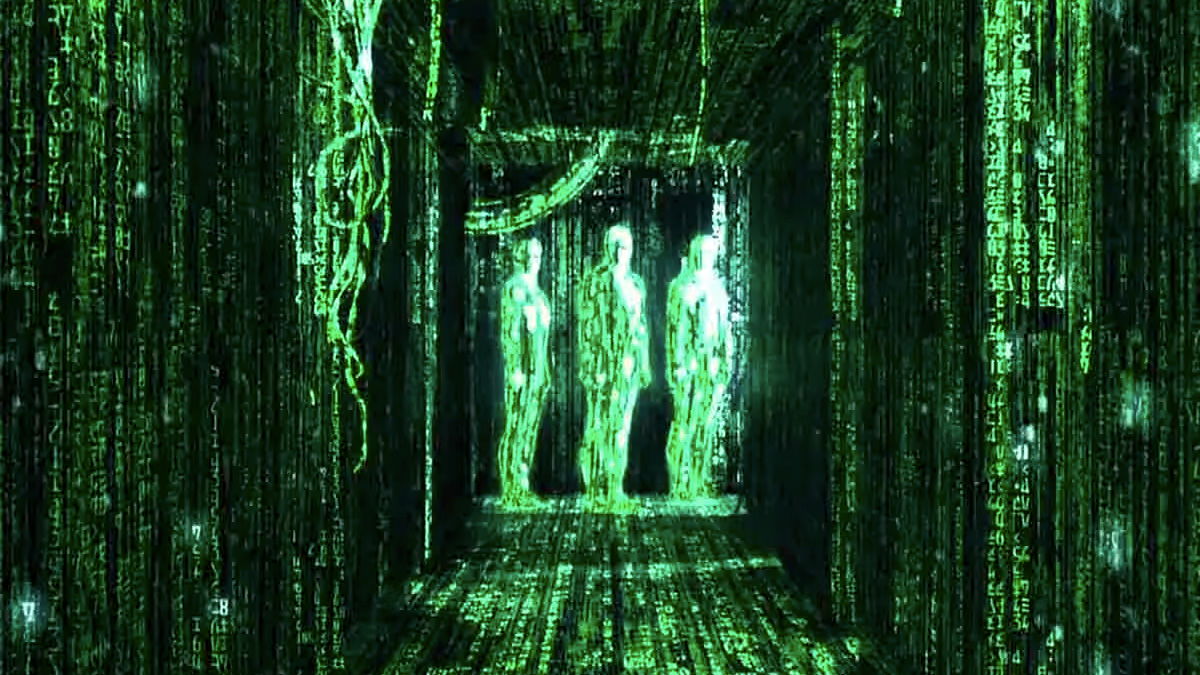Core Data:
- Vision: The Matrix
- Type: Popular culture – Film
- As Seen In: The Matrix, The Matrix Reloaded, The Matrix Revolutions
- Envisioned: 1999
- Visionary: The Wachowskis
- Target Date: 2199 (approx.)
Overview:
Despite borrowing from numerous earlier movies and graphic novels – notably 1995 anime classic Ghost in the Shell – The Matrix proved a revelation when it arrived in cinemas in 1999. By mixing ingenious sci-fi concepts with philosophical musings and groundbreaking fight scenes, director/writer sisters the Wachowskis rewrote the rulebook for Hollywood blockbusters.
The Matrix is arguably cinema’s definitive virtual reality construct, a simulation so vast and sophisticated that it convinces the entire human race that it’s actually the real world. There is a downside, however – it’s really a prison for our species, constructed by the race of hyper-intelligent machines that now rule planet Earth.
While the central premise of The Matrix is similar to that of The Terminator – computers built by humans turn on their creators – the Wachowskis took humanity’s plight in a very different direction. Yes, both franchises feature a future where Earth is a dystopian wasteland, but the machine overlords in The Matrix cushion the blow by incarcerating homo sapiens in the eponymous digital jail – a set-up that allows them to use us as batteries to power their civilisation.
But what makes the simulation so exciting is the opportunities it can offer the people inside. Where most of the Matrix’s residents remain blissfully unaware their everyday lives are made of computer code, a small number of freedom fighters – including Morpheus, Trinity and chosen one Neo – have worked out how to game the system. They become superheroes in all but name, bending the rules of the Matrix to take the fight back to their AI captors – all in the hope of freeing humanity from its existence as a power source.
One question remains, though: with a metaverse this realistic, why would anyone want to go back to the hellscape of the so-called “desert of the real”?

Key Tenets:
- Experience: Users have no idea they’re occupants of The Matrix. As far as they’re aware, they’re simply playing out their normal lives – whether they’re watching TV, going to work or sleeping, participants feel like they’re living on 20th century Earth.
- The physics and “rules” inside the Matrix are the same as in the real world. If an avatar dies within the Matrix, their physical body dies as well – it’s explained that “the body cannot live without the mind”.
- The experience is so immersive that nobody is aware that anything exists outside their perception of the real world – though glitches sometimes appear in the system where the simulated reality has been altered in some way. These glitches can manifest themselves in weird phenomena such as déjà vu.
- It is possible to be “freed” from the Matrix, if the participant opts to take the so-called “red pill” – essentially a tracking device that shows other freed humans where to find them.
- After leaving the Matrix, it is possible to reconnect to the simulation. Once a participant returns in this way, they can learn an impressive selection of superhuman abilities (including super-fast reflexes, gravity-defying kung fu and flight). They also have access to a vast arsenal of weapons and lots of very dark sunglasses.
- Behaviour that doesn’t fit with the ethos of the machines who created the Matrix is monitored – and eliminated – by Agents, sentient programs with the dress sense of a US government operative.
- Hardware: Humans are quite literally born to connect to the Matrix, birthed and raised in giant farms.
- Participants live out their lives in pods – effectively giant sacs of amniotic fluid designed to keep them alive. In addition to the numerous connections that provide sustenance and remove waste, people are linked to the Matrix by a “headjack”, an invasive data port inserted directly into the brain. Freed humans can also use this headjack to log back into the Matrix.
- The electrical energy generated by the active human brain is fed back into the grid to power the machines.
- When the human body can no longer function, it’s disconnected from the Matrix and disposed of.
- Economics: Within the Matrix, the economic system is modelled on that of the late 20th century – Earth’s machine overlords did experiment with a more utopian system, but it turned out our human minds required a degree of imperfection to function.
- Participation in the Matrix costs you nothing or everything, depending on your point of view – you don’t need to pay any money to take part, but it does require you to completely surrender your entire existence. Then again, it’s not as if you have a choice in the matter.
- It’s unclear whether the machines’ civilisation has any need for a commodity-based economy.
- IP: If it existed on Earth in 1999, you’ll be able to find it in the Matrix – with the possible exception of The Matrix movies because, well, that would just be too meta.
- Company: The Matrix is run exclusively by a consortium of the machines who have enslaved humanity.
State of Play (September 2021)
- Experience: The rise of online gaming has given humans the chance to interact with other humans from around the world, exploring vast, sophisticated metaverses. The likes of Second Life, World of Warcraft and Fortnite enable players to take on new personas, with new abilities, in new scenarios, though they’re not quite a substitute for the real world – yet.
- Hardware: They’re not quite at the point of delivering complex computer simulations direct to the cerebellum, but neural interfaces do exist – electronic brain implants are used to treat Parkinson’s disease, while simple EEG headsets can already be used to control computers/games.
- In the movies, outsiders view the Matrix as a cascade of green letters and numbers because their displays aren’t sophisticated enough to visualise the simulation. In 2021, however, imaging technology is advanced enough to create complex computer generated worlds in real time – a tool frequently used in the film industry.
- Economics: Using human brains to generate electricity is a woefully impractical way to power a civilisation. According to neuroscientist Dr Henning Beck, the human brain functions on just 20 watts. Even if all that electricity could be harnessed – not likely, seeing as physics tells us lossless energy transfer is currently impossible – that would only be enough power to illuminate a light bulb. Even with more than seven billion of us, that’s going to fall way short of the machines’ energy requirements. They’d be much better off investing their efforts in alternative energy sources, and wiping out people entirely – at least that way they wouldn’t run the risk of a human uprising every few years.
- Company: As far as we’re aware, malevolent AI isn’t about to take over the world. As far as we’re aware…
Reality check: Some way to go
The world is significantly more connected than it was when the original Matrix was released in 1999, but most of the Wachowskis’ ideas are still closer to science fiction than science fact.
While online metaverses are getting more sophisticated all the time, the days when we consume them through direct neural interfaces – rather than via a screen – are still some way off. And despite numerous advances in artificial intelligence in recent years, current computers are unlikely to rise up and turn us all into batteries. For that we should all be thankful.
Further Reference:
- The Matrix (film)
- The Matrix Reloaded (film)
- The Matrix Revolutions (film)
- The Animatrix (animated anthology series)
- Metaverse
- Virtual Reality
A self-confessed full-time geek, freelance journalist Richard has spent most of his career writing about sci-fi and fantasy – including more than a decade on staff for SFX magazine. He's particularly keen on franchises with "Star" in the title.



































